USS Baltimore CA-68

Reviewed by Sean Hert

| HISTORY | |||||||||||||||||||||||||||||||||||||||||||
| The Baltimore class heavy cruisers were the pinnacle of
US heavy cruisers during WW II. Developed after the limitations of the
Washington and London Naval treaties had expired, these cruisers entered
the war too late to see much surface action, unlike their earlier sisters.
Armed with an impressive array of Dual-Purpose and AA secondary armaments,
these cruisers served mainly as carrier escorts and for shore bombardment
purposes; jobs which they performed admirably.
The USS Baltimore CA-68 was commissioned in April of 1943, and after workups, first saw action of the coast of Makin Island later in 1943. Baltimore continued to serve through WW II, staying in the Pacific theatre throughout the war. Baltimore was placed in reserve in 1946, but was recalled to duty in 1951, where Baltimore finally got to see the Atlantic and Mediterranean, before returning to Pacific Duty. Place back into reserve in 1956, she was never again called to serve. Baltimore was scrapped in 1972, having won 9 battle stars in during her service. Yankee Modelworks, long the sole provider of many 1/350 US subjects, has filled a long standing hole in the available cruisers lineup with this kit of USS Baltimore. This impressive model is over 22" long, and can be build in either a full hull or waterline version. |
|||||||||||||||||||||||||||||||||||||||||||
| HULL PARTS | |||||||||||||||||||||||||||||||||||||||||||
| Baltimore's hull is cast in 2 solid pieces, upper and lower,
split at the waterline. There is a slight rough texture to the hulls parts.
The hull halves have no apparently overpour, or casting stub, and come
close to lining up, having only a slight misalignment. Baltimore was 664
feet in length at the waterline, which is 22.76" in 1/350; Yankee Modelworks's
upper hull measures out about .25" too long, and the lower about .125"
too long. In beam, the kit hull is merely a few thousandths too narrow-
well within the tolerances of hobby casting resins. The armor belt on the
hull appears a bit too pronounced, when compared to photos.
The upper deck has regular planking rows, with only one seam- which will be covered by the forward superstructure. None of the superstructure is cast into the upper hull, and will need to be attached. Close attention will need to be paid when attaching these parts; there are no indicators on the deck to guarantee correct placement. |
|||||||||||||||||||||||||||||||||||||||||||
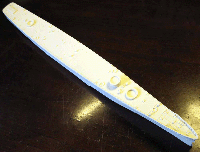 |
|||||||||||||||||||||||||||||||||||||||||||
|
|||||||||||||||||||||||||||||||||||||||||||
| RESIN PARTS | |||||||||||||||||||||||||||||||||||||||||||
| The resin parts for this kit are packages in 2 zip lock
bags. The first bag primarily holds the superstructure pieces needed for
Baltimore. Most of the resin parts in this kit have a slight casting wafers
attached to the bottom, which are much easier to remove than pour plugs.
Some of the parts do show some flash from mold wear, but shouldn't prove
much of a challenge to clean up. The resin parts are nicely cast, and bubble
free throughout the kit. No other casting apparent defects can be found
either.
The parts line up nicely, and should build up quickly. Many of the blast shields are cast in place with the superstructure parts, making them a bit thick, but it rarely detracts from the appearance of these parts. Page 4 of the instructions has a complete list of the resin parts included in these bags. |
|||||||||||||||||||||||||||||||||||||||||||
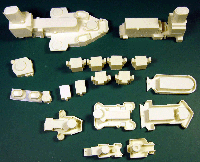
Parts Bag A |
|||||||||||||||||||||||||||||||||||||||||||
|
|||||||||||||||||||||||||||||||||||||||||||
| This bag held the main turrets, the 5" gun houses, 20mm
and 40mm tubs, and some other parts. The 5" twin gun house appears to be
the same one YKM has used for years, but cast from a newer mold; the parts
are crisper and now have a remnant of a casting "wafer" on the bottom.
Many of the other, smaller parts in this bag are cast on sprues, predominately
the many vents and capstans
The 8" turrets are crisply cast, with only a slight casting wafer to remove. Some flash is present around the rangefinders. The most disappointing thing about these turrets is the lack of any detail on the turret face. These turrets should have large, distinctive oval openings for the guns, but there is nothing present. In fact, there are no indications on the turret to aid placement of the barrels in the proper locations. |
|||||||||||||||||||||||||||||||||||||||||||
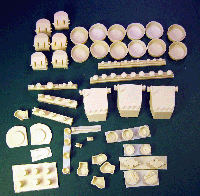
Parts Bag B |
|||||||||||||||||||||||||||||||||||||||||||
|
|||||||||||||||||||||||||||||||||||||||||||
| METAL PARTS | |||||||||||||||||||||||||||||||||||||||||||
| Baltimore comes with a heavy little bag full of white metal
parts. Many of these parts are dated and rough, and just aren't up to modern
standards, or even the levels of detail found in the rest of the kit. That
being said, the plastic 40mm guns are still some of the best ones out there.
Page
5 of the instructions has a complete list of the metal parts included
in this bag.
The rudder appears to be too large and of an incorrect shape. Given the rough texture of this part, some sanding and shaping will be needed to correct. The 20mm's and ammo boxes are disappointing. The ancillary details, like Pelorus, paravanes and life rafts are quite acceptable- this kit was short 2 life rafts, however. The large and small flag bags are metal cast, but listed as resin pieces in the instructions. |
|||||||||||||||||||||||||||||||||||||||||||
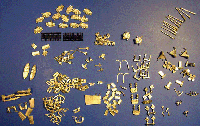
Metal Parts |
|||||||||||||||||||||||||||||||||||||||||||
|
|||||||||||||||||||||||||||||||||||||||||||
| PHOTOETCH | |||||||||||||||||||||||||||||||||||||||||||
| The kits 2 photoetch frets are very extensive and detailed.
They have all the standard photoetch parts you expect to find; ladders,
railings, radars, cranes and catapults. There are some interesting walkway
pieces, and a large number of bracing pieces for platforms throughout the
ship. Those braces should prove challenging to place, but will make for
some great detail across the entire ship.
There is a third, smaller fret, with 14 duplicates provided, for the shields around each 40mm quad. |
|||||||||||||||||||||||||||||||||||||||||||

Sheet #1 |
|||||||||||||||||||||||||||||||||||||||||||
|
|||||||||||||||||||||||||||||||||||||||||||

Sheet #2 |
|||||||||||||||||||||||||||||||||||||||||||
|
|||||||||||||||||||||||||||||||||||||||||||
| DECAL | |||||||||||||||||||||||||||||||||||||||||||
| YKM's standard 1/350 WW II USN decal set | 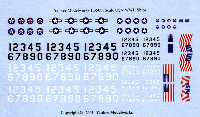 |
||||||||||||||||||||||||||||||||||||||||||
| INSTRUCTIONS | |||||||||||||||||||||||||||||||||||||||||||
| An extensive 41 page instruction booklet, complete with 3D CAD steps
and images to guide painting. The first pages include a history of Baltimore,
and some basic instructions on working with resin to aid novices. Some
painting hints and tips are the only thing missing from this front section.
Pages 4&5 have a parts list for the resin and metal parts, with illustrations,
which should prove to simplify matters.
These CAD based instructions are a vast improvement over the hand written and hand drawn instructions of the past. Each step is laid out in order, with photoetch parts added as you build. Some of the CAD images show more detail or differ from the kit parts listed in the step, so pay close attention to each step. Some measurements to aid in the placement of the deckhouses and gun barrels would have been an appreciated addition. This booklet ends with copies of some images of CA-68 in 1944, the BuShips Measure 32/16d painting guide and a color painting guide with paint recommendations, though this page does refer to USS Baltimore as "USS Miami." |
|||||||||||||||||||||||||||||||||||||||||||
|
|||||||||||||||||||||||||||||||||||||||||||
| CONCLUSIONS | |||||||||||||||||||||||||||||||||||||||||||

It is nice that YKM released a kit of this historically important USN heavy cruiser. With the cleanly cast hull and superstructure parts, this kit will build up into an accurate representation of a 1944 Baltimore. I would like to see brass barrels included in this kit for the main rifles and 5" DP battery. Brass barrels have quickly become a standard upgrade in our hobby, and are a vast improvement over the soft metal kind. Baltimore is a good kit, showing the evolution of Yankee Modelworks resin casting is always improving. The kit is only really marred by the use of dated and worn white metal parts. With plenty of aftermarket manufactures making updated and improved versions of these parts, as well as recent efforts by plastic manufacturers, Yankee Modelworks needs to update their accessories have a modern, competitive product. Recommended for modelers with previous some resin and photoetch experience. This is kit #YKM-35144 with a MSRP of $325.00, but can be found much cheaper from our sponsors. This is only one of the many kits produced by Yankee Modelworks. See the whole line on their website. |
|||||||||||||||||||||||||||||||||||||||||||